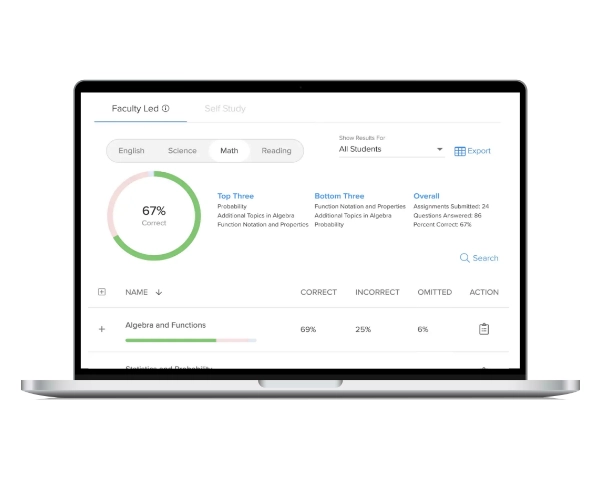“What do you want to be when you grow up?” Adults and teachers ask this of young children all the time. Once students reach high school, however, career conversations become much more serious, which is why educators must strive to help their students explore potential career paths in a meaningful way.
Traditional Career Guidance for Students (And Why It Doesn't Work)
For many students, career conversations often begin — and end — with 1 of 2 straightforward, well-meaning questions: "What do you want to study in college?" or "What do you want to do after you graduate?" While these questions are well-intentioned, they rarely foster meaningful discussions and can ultimately fall short.
Research indicates that career choices are more intricate than merely selecting a major or profession. According to the National Center for Education Statistics, about 30% of undergraduate students change their major within the first 3 years of enrollment. Approximately 54% pursue careers outside their field of study.1, 2 Despite this reality, many of your career discussions with students may urge them to choose a profession early and remain committed to it, often placing greater emphasis on STEM fields than other career pathways. While STEM careers are valuable, they may not suit every student, and job market trends can shift — what was once a secure career may become less stable over time.
Rather than concentrating solely on a student's choice of major or pressuring them to select a specific career, your conversations with your students should encourage them to explore a range of fields and industries where they can leverage their unique talents and skills.

Effective Career Guidance for Students
Educators invested in guiding young people toward fulfilling careers should ask “how can I help” rather than “why should I help.” How can you support your students in exploring career options without pressuring them into premature decisions? How can you prepare them for success while allowing space for discovery?
The key is providing career guidance activities for high school students and fostering open-ended conversations rather than expecting immediate answers. Instead of asking, “What job do you want?,” center your student career conversations around:
- Career interests and skill strengths
- Potential career demand and competition
- Lifestyle considerations and long-term goals
- Potential salary expectations
- Career skillset, degree, and time requirements
This shifts the discussion from rigid job titles to broader career pathways that align with a student's interests, strengths, and values.
Explore Interests and Skill Strengths Together
Begin a career conversation by asking your students, “What are you good at, and what do you enjoy doing?” Encourage them to reflect on their skills and interests by discussing the subjects and activities they are drawn to. If they're uncertain, suggest they take a career assessment or speak with the school's guidance counselor to help them identify potential fields that align with their strengths.
If a student shows interest in a specific career, ask them why. What excites them about that field? Do they have a clear understanding of what daily work in that career entails? Help them explore related career paths they may not have considered. For instance, a student who enjoys writing might not realize there are opportunities in technical writing, content strategy, or marketing beyond traditional journalism or novel writing.
Many career conversations stop at this point. However, while identifying students' interests and skill strengths is a valuable starting point, it should be just that — a starting point.
Discuss Career Demand and Competition
When a student expresses interest in a career, discuss the realities of job demand and competition. While your students should pursue careers that align with their passions, they also need to be informed about job availability, earning potential, and future career trends.
Traditionally, students have been encouraged to pursue careers in fields including medicine, law, and engineering because they are perceived as stable. However, job security isn't guaranteed in any field. Emerging industries such as artificial intelligence, cybersecurity, and renewable energy are growing rapidly, while some once-secure careers may face automation or shifting market demands.
Rather than discouraging students from pursuing competitive careers, guide them toward implementing strategies for success. If a student aspires to be a professional musician or athlete, discuss the importance of having backup plans, additional skill sets, or side careers that align with their primary passion.

Introduce Lifestyle Considerations and Thinking About Long-Term Goals
Career satisfaction isn't just about job titles — it's about how well a career aligns with a person's desired lifestyle. Students should consider factors such as work-life balance, job stability, and long-term personal goals.
Encourage your students to ask themselves:
- Do I want a job with a predictable schedule, or do I thrive in dynamic environments?
- How much financial security do I want, and what level of income will provide that?
- Do I want a career that requires frequent travel, or do I prefer stability?
For example, a student who values flexibility might enjoy freelance or remote work, while another who prioritizes structure may prefer a corporate or government job. Helping students think critically about lifestyle factors will prepare them for long-term career satisfaction.
Talk About Potential Salary Expectations
Historically, career conversations have shied away from discussions about salary because it's seen as materialistic or unimportant compared to passion and fulfillment. However, financial security plays a major role in career satisfaction, and students deserve transparent information about earning potential.
While salary shouldn't be the sole deciding factor, students should understand what different careers pay and what factors affect income levels. For example, a dentist might earn between $130,000 and $240,000 per year, while a graphic designer's salary may range from $50,000 to $100,000.3, 4 Additionally, students should be aware that location, experience, and industry demand all influence salaries.
Helping students make informed financial decisions early can prevent future stress related to student debt, underemployment, or career dissatisfaction.
Consider Career Requirements
Every career path comes with its own education, certification, and training requirements. Some professions require years of specialized schooling, while others offer alternative pathways.
For example:
- Becoming a doctor requires 8+ years of education and residency.5
- Teaching requires a bachelor's degree, state certification(s), and — in some states — a master's degree.6
- Skilled trades, such as electricians and plumbers, require apprenticeships and licensing but can offer high salaries with shorter training periods.
Students should research what level of education is necessary for their desired careers and consider whether they are willing to commit to that path. Understanding these factors helps students make informed decisions about their long-term career goals.
The Role of Educators in Career Conversations With High School Students
You play a critical role in helping your students navigate their career options. High school should be a time for career exploration, not just academic preparation. Incorporating career and technical education (CTE) programs into the curriculum, hosting career fairs, and providing mentorship opportunities can give students real-world insight into various career paths.
By supporting your students in exploring careers, developing skills, and setting realistic goals, you can help bridge the gap between academic learning and workforce readiness. The more prepared students are for life after high school, the more confident they will be in making informed career decisions.

Frequently Asked Questions (FAQs)
Which factors affect student career choices?
Personal interests, job market trends, salary expectations, education requirements, and work-life balance all influence career decisions.
Which emerging career fields can be supported by AP and CTE integration?
Industries such as cybersecurity, renewable energy, and AI-driven analytics benefit from AP and CTE integration.
What are some career-related activities that have the greatest impact on students?
Job shadowing, career fairs, internships, and mentorship programs provide valuable hands-on experience that helps students explore potential career paths.
References
- National Center for Education Statistics. (2018). What percentage of students change majors? U.S. Department of Education. Retrieved from https://nces.ed.gov/pubs2018/2018434/index.asp
- Next Gen Personal Finance. (2023). What percent of college graduates end up working in the field of their major? Retrieved from https://www.ngpf.org/blog/question-of-the-day/qod-what-percent-of-college-graduates-end-up-working-in-the-field-of-their-major/
- Jobted. (n.d.). Dentist salary in the United States. Retrieved from https://www.jobted.com/salary/dentist
- Builtin. (n.d.). Graphic designer salaries in the United States. Retrieved from https://builtin.com/salaries/us/graphic-designer
- Med School Insiders. (2023). How long does it take to become a doctor? Retrieved from https://medschoolinsiders.com/pre-med/how-long-does-it-take-to-become-a-doctor/
- Certification Map. (n.d.). How to become a teacher. Retrieved from https://certificationmap.com/how-to-become-a-teacher/
- Counselor Clique. (n.d.). Career readiness: Supporting students through career exploration. Retrieved from https://counselorclique.com/career-readiness/
- Evidence-Based Mentoring. (2022). How can we help young people find careers they care about? It starts with a conversation. Retrieved from https://www.evidencebasedmentoring.org/how-can-we-help-young-people-find-careers-they-care-about-it-starts-with-a-conversation/




